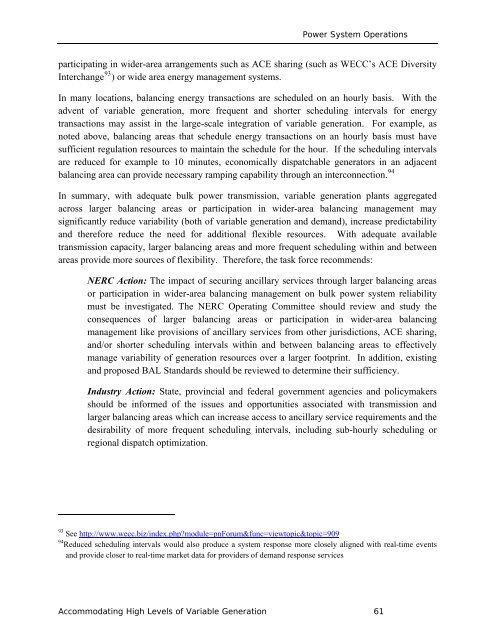Accommodating High Levels of Variable Generation - NERC
Accommodating High Levels of Variable Generation - NERC
Accommodating High Levels of Variable Generation - NERC
Create successful ePaper yourself
Turn your PDF publications into a flip-book with our unique Google optimized e-Paper software.
Power System Operations<br />
participating in wider-area arrangements such as ACE sharing (such as WECC’s ACE Diversity<br />
Interchange 93 ) or wide area energy management systems.<br />
In many locations, balancing energy transactions are scheduled on an hourly basis. With the<br />
advent <strong>of</strong> variable generation, more frequent and shorter scheduling intervals for energy<br />
transactions may assist in the large-scale integration <strong>of</strong> variable generation. For example, as<br />
noted above, balancing areas that schedule energy transactions on an hourly basis must have<br />
sufficient regulation resources to maintain the schedule for the hour. If the scheduling intervals<br />
are reduced for example to 10 minutes, economically dispatchable generators in an adjacent<br />
balancing area can provide necessary ramping capability through an interconnection. 94<br />
In summary, with adequate bulk power transmission, variable generation plants aggregated<br />
across larger balancing areas or participation in wider-area balancing management may<br />
significantly reduce variability (both <strong>of</strong> variable generation and demand), increase predictability<br />
and therefore reduce the need for additional flexible resources. With adequate available<br />
transmission capacity, larger balancing areas and more frequent scheduling within and between<br />
areas provide more sources <strong>of</strong> flexibility. Therefore, the task force recommends:<br />
<strong>NERC</strong> Action: The impact <strong>of</strong> securing ancillary services through larger balancing areas<br />
or participation in wider-area balancing management on bulk power system reliability<br />
must be investigated. The <strong>NERC</strong> Operating Committee should review and study the<br />
consequences <strong>of</strong> larger balancing areas or participation in wider-area balancing<br />
management like provisions <strong>of</strong> ancillary services from other jurisdictions, ACE sharing,<br />
and/or shorter scheduling intervals within and between balancing areas to effectively<br />
manage variability <strong>of</strong> generation resources over a larger footprint. In addition, existing<br />
and proposed BAL Standards should be reviewed to determine their sufficiency.<br />
Industry Action: State, provincial and federal government agencies and policymakers<br />
should be informed <strong>of</strong> the issues and opportunities associated with transmission and<br />
larger balancing areas which can increase access to ancillary service requirements and the<br />
desirability <strong>of</strong> more frequent scheduling intervals, including sub-hourly scheduling or<br />
regional dispatch optimization.<br />
93 See http://www.wecc.biz/index.php?module=pnForum&func=viewtopic&topic=909<br />
94 Reduced scheduling intervals would also produce a system response more closely aligned with real-time events<br />
and provide closer to real-time market data for providers <strong>of</strong> demand response services<br />
<strong>Accommodating</strong> <strong>High</strong> <strong>Levels</strong> <strong>of</strong> <strong>Variable</strong> <strong>Generation</strong> 61
















